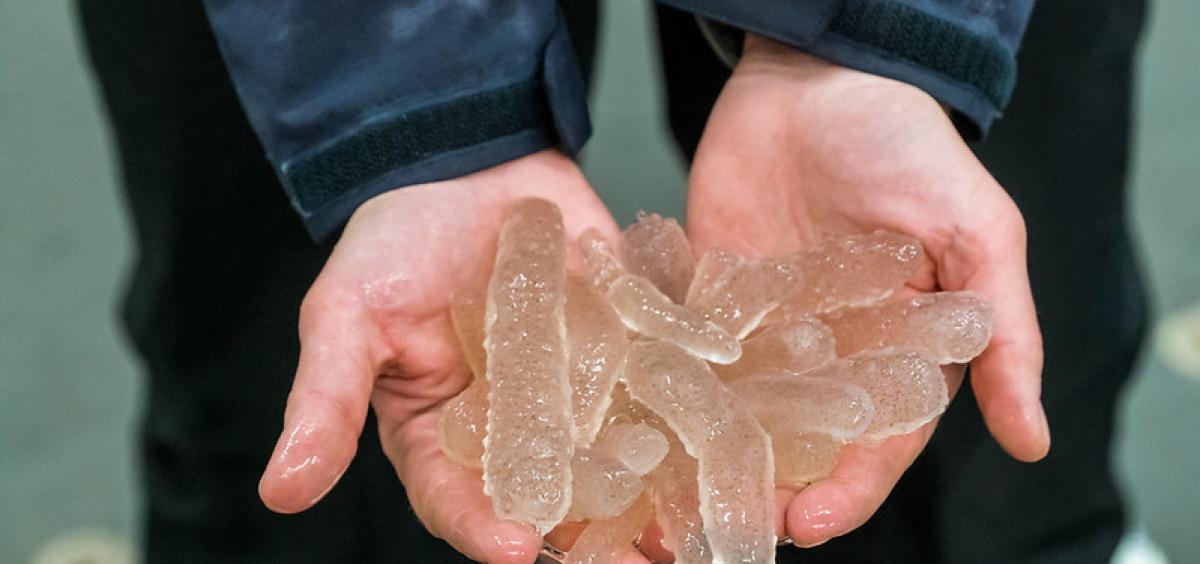
NEWPORT, Ore. – Marine heat waves in the northeast Pacific Ocean create ongoing and complex disruptions of the ocean food web that may benefit some species but threaten the future of many others, a new study has shown.
The study, just published in the journal Nature Communications, is the first of its kind to examine the impacts of marine heat waves on the entire ocean ecosystem in the northern California Current, the span of waters along the West Coast from Washington to Northern California.
The researchers found that the biggest beneficiary of marine heat waves is gelatinous zooplankton – predominantly cylindrical-shaped pyrosomes that explode in numbers following a marine heat wave and shift how energy moves throughout the food web, said lead author Dylan Gomes, who worked on the study as a postdoctoral scholar with Oregon State University’s Marine Mammal Institute.
“If you look at single species interactions, you’re likely to miss a lot,” Gomes said. “The natural effects of a disturbance are not necessarily going to be straightforward and linear. What this showed us is that these heat waves impact every predator and prey in the ecosystem through direct and indirect pathways.”
The project was a collaboration by Oregon State University and the National Oceanic and Atmospheric Administration. Joshua Stewart, an assistant professor with the Marine Mammal Institute, mentored Gomes and co-authored the paper.
“What I found both alarming and fascinating is the extent to which these pyrosomes absorb all of the energy in the system,” Stewart said. “Because nothing else really eats the pyrosomes, they just become this dead end, and that energy is not available for anyone else in the ecosystem.”
Marine heat waves are periods of prolonged, unusually warm ocean temperatures. The prevalence and intensity of marine heat waves is increasing around the globe. While the impacts of these heat waves on marine species have been well-documented on individual and population levels, the effects on the entire ecosystem have not been well understood, Gomes said.
To gain a more holistic view of the impact of marine heat waves, Gomes updated an end-to-end ecosystem model with new data on marine life throughout the ocean food web that was collected during local biological surveys.
He then compared how the food web worked before and after a recent spate of marine heat waves, including a large, well-documented event in 2013-2014 known as “the blob.” Much of the new data used in the model was collected following that event as researchers tried to better understand its impacts.
Some of the impacts were predictive – pyrosomes, for example, are known to thrive in warmer waters – but the analysis also showed that the ecosystem functions in ways that are not intuitive, Gomes said.
For example, the modeling showed how the dominance of pyrosomes drew energy out of the food web. That loss of energy is most likely to affect fish and marine mammals that are higher up the food chain, potentially impacting economically important fisheries and recovery efforts for threatened or endangered species, Stewart said.
Huge influxes of pyrosomes in the waters and on beaches in the Pacific Northwest in 2017 and 18 drew widespread public attention. Data from those events was included in the updated model.
The updated model used in the study could help commercial fisheries adapt harvest strategies that are impacted when fish commonly found in one area move to escape the encroaching warm water or their populations drop due to lack of available food following a marine heatwave.
Numbers of Pacific jack mackerel, for example, have increased following marine heat waves, but so far, fisheries have not shifted to catching them, the researchers noted.
The researchers’ methods could also provide a template for future research to understand the impact of these events elsewhere, Gomes said.
Additional coauthors of the paper are James Ruzicka of NOAA’s Pacific Islands Fisheries Science Center and Lisa Crozier, David Huff and Richard Brodeur of NOAA’s Northwest Fisheries Science Center. Gomes is now with U.S. Geological Survey.
The Marine Mammal Institute is part of Oregon State’s College of Agricultural Sciences and is based at Hatfield Marine Science Center in Newport. NOAA’s Northwest Fisheries Science Center also has a research station at Hatfield.
About OSU's Hatfield Marine Science Center: The center is a research and teaching facility located in Newport, Ore., on the Yaquina Bay estuary, about one mile from the open waters of the Pacific Ocean. It plays an integral role in programs of marine and estuarine research and instruction, as a laboratory serving resident scientists, as a base for far-ranging oceanographic studies and as a classroom for students. In addition to Oregon State researchers and students, its campus includes research activities and facilities from five different state and federal agencies.
Michelle Klampe, 541-737-0784, [email protected]
Joshua Stewart, 541-867-0315, [email protected]; Dylan Gomes, [email protected]
Click photos to see a full-size version. Right click and save image to download.